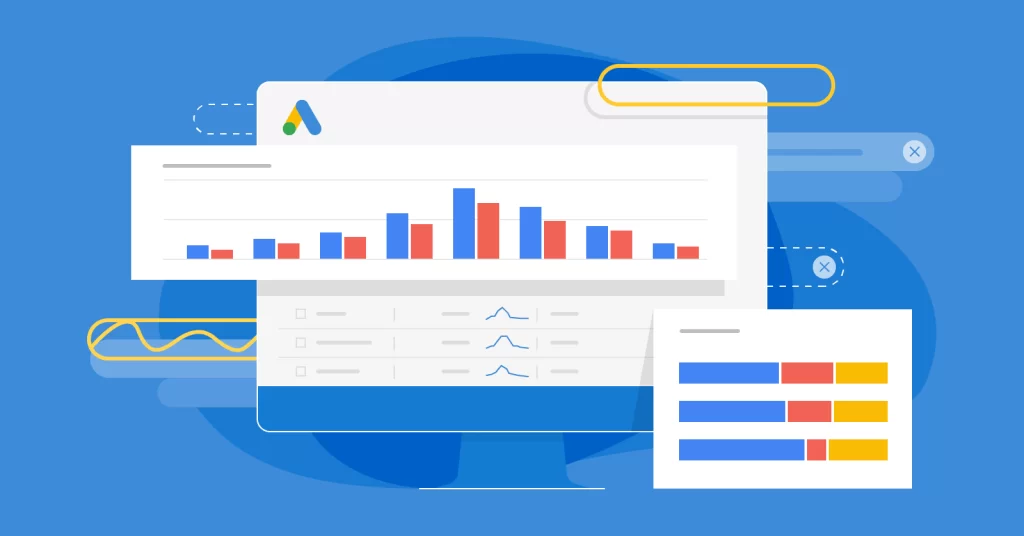The Google Ads keyword planner is a powerful tool for building strong keyword lists and is useful to get your PPC campaign off to start running. The features are completely free to use in Google Ads and it is a tool for generating target keywords and advanced estimations that could help plan your marketing strategy. Using the Google keyword planner tool, you could search for ad groups and well-performing keywords ideas. Even it provides you with a combination of keywords list to create new keywords. While creating campaigns you could choose competitive bids and budgets in the keyword planner tool.
For example, if you run a product-based business selling homemade and organic products across the country. The Google keyword tool would help to identify the search terms, phrases, and potential of keywords users might search on google related to your business. You might use the phrase organic products or handmade products, google keyword planner tool might show related and frequently searched terms like handmade crafts or organic, etc.
When you understand the steps of using the google ads keyword tool, you could adopt several strategies to help take your business to the next level. Following the tips to use the keyword planner tool and grow your business.

1. Use Basic Filtering To Get Your Audience
While using the keyword planner tool, you will give four things:
- Searching For New Keywords: The tool allows you to search in a website, phrase, or category to generate new keywords related to your business.
- Multiple Keyword Lists: Create new combinations with two separate keyword lists.
- Get Search Volume And Tends: Google keyword planner shows you the historical trending keywords and search volume data.
- Get Clicks And Cost Performance Forecasts: Provide you with the performance projections of keyword lists based on average bids and your budget.
When you input keywords in any of the above-given options, the tool provides a report which you could filter based on a variety of elements. The keywords have a high search volume globally, you could filter the keywords using a specific location whether it is a popular relevant search term for your website.
REACH
- Location: Provides trending keywords and search volume data depending on a specified geographic location or range.
- Language: Provides search volume data based on a specified language and it could be helpful for multiple languages versions or pages of your website. For example, English and Spanish.
- Search Network: Find the medium of data that comes. Google is a default data source medium, you could also choose Google and Google search partners.
- Negative keywords: Filter out the unwanted comments or phrases on your website. You can also put restrictions for some words like free.
DATE RANGE
While you create a specific date range in the tool, you could see average monthly searches for that period. If you want to know the well-performing keywords during different times of the year, you could compare two different date ranges. It helps you to alter the strategy of your campaign timing.
KEYWORD FILTERS
- Average Monthly Searches: The keyword tool filters the keywords based on average monthly searches in Google for selected dates. Generally, keywords with high search volume like ten thousand plus average monthly searches are more difficult to compete with higher suggested bids. If you have started a new campaign, just focus on keywords with mid-level search volume. May help you to avoid spending more budgets on a few keywords.
- Suggested Bid: This could allow you to choose keyword categories that help you to maintain control of your budget. Use the cost per click of your website to calculate the suggested bid because the other advertisers are also paying for keywords with the same search network settings and locations.
- Ad Impression Share: Calculate ad impression share from the number of times users will see your ad divided by the total number of searches that match your target keyword in the last month in your selected location and network.
- Organic Impression Share: Calculate the organic impression share from the percentage of times your website organically showed up on google. The best way to increase organic impression for your website is to build backlinks from high authority sites and gain potential visitors. It also provides data of unpaid web searches of keywords.
- Organic Average Position: This shows you the pages from your website ranking regularly.
- Competition: You could filter keywords by high, medium, and low difficulty. Filter keywords based on the difficulty to receive a position. For small businesses it is recommended to filter for medium to low difficulty, so you can make more of your budget.

2. Use Quality Keywords
Google keyword planner tools help you to identify the new terms of keywords and phrases potential users are using to search for the business. You allow viewing Google keywords generated by:
- Keyword: Type words or phrases related to your website or business to get long-tail keywords or new ideas from people.
- Landing Page: Enter a page on your website and the keyword planner will read the page and generate relevant keywords to your page.
- Product Category: Select the specific product category that well describes your business to find well-performing keywords frequently searched with your business. This helps you to identify the new keywords that you might not know from potential customers.
Choose keywords that are suitable for your business and come with the majority of your budget.
3. Reach Geographic Audiences
In the keyword planner tool, you could customize your ads display based on language and location. While the keywords have a high search volume, the tool will filter your relevant keyword in your local area. Keyword planner provides you the average monthly searches, keyword volume, search trends, etc.,
The tool filters will also design your campaigns with different languages. If your website is customized in both English and Spanish, the tool helps you to discover the most relevant keyword in each language. You need to create two separate ad groups to reach both language audiences.
4. Focus On Your Competitors Pay
The competitive level of keyword choices depends on their costs. The cost of high competition keywords is more per average bid, and using it to gain a top viewing position.
Google Ads keyword planner tool could help you to find effective keywords that are more budget-friendly. And also shows you other advertisers’ keyword costs. The tools provide a bid column to show the average amount for rank on top-level position for a particular keyword. You could see the keyword that is to reach your budget and build your campaign to improve your visibility on search results.
The bidding feature shows a good estimation of general cost, Google’s estimate tool provides an estimate to rank on the first results page based on your keywords quality score and current competition.
To access the estimated first-page bid metric for your keywords,
- View the keywords tab and hit the columns button
- Choose to modify columns
- In attributes, add estimate first-page bid and click the save button
- Add estimated top page bid and save
5. Analyze Your Plan To Make More Budget
You could add your keyword plan in the button to discover. Once you add your keyword plan, You could set a daily budget and location to know the detailed forecast about the target keywords.
While you have a bunch of keywords for your group, click the review forecast button to show the estimated clicks, average positions, clicks, and average conversion rate for your potential keywords. You could easily analyze your budget range with the forecast review. Refine your keywords by using your findings to add and delete the keyword that will help most of your budget.
Conclusion
The Google Ads keyword planner is a tool to customize your keywords more efficiently. The report provides you with the top Google search terms and number of clicks, impressions, average position, and click-through rate. With a keyword planner tool, You could lay out the work for a successful PPC campaign. Using the above tips, you can successfully grow your online marketing campaign.


